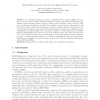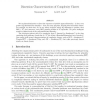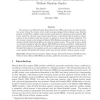94
Voted
ESORICS
2012
Springer
13 years 16 days ago
2012
Springer
We initiate the study of unique group signature such that signatures of the same message by the same user will always have a large common component (i.e., unique identifier). It ...
108
Voted
PKC
2012
Springer
13 years 17 days ago
2012
Springer
Abstract. An unresolved problem in research on authenticated key exchange (AKE) is to construct a secure protocol against advanced attacks such as key compromise impersonation and ...
121
Voted
ASIACRYPT
2011
Springer
13 years 10 months ago
2011
Springer
We provide constructions of (m, 1)-programmable hash functions (PHFs) for m ≥ 2. Mimicking certain programmability properties of random oracles, PHFs can, e.g., be plugged into ...
71
Voted
TCS
1998
14 years 9 months ago
1998
Results on random oracles typically involve showing that a class {X : P(X)} has Lebesgue measure one, i.e., that some property P(X) holds for “almost every X.” A potentially m...
74
Voted
CC
2008
Springer
14 years 10 months ago
2008
Springer
We use derandomization to show that sequences of positive pspace-dimension
89
Voted
CRYPTO
2008
Springer
14 years 12 months ago
2008
Springer
Abstract. The study of deterministic public-key encryption was initiated by Bellare et al. (CRYPTO '07), who provided the "strongest possible" notion of security for...
104
Voted
EUROCRYPT
2004
Springer
15 years 1 months ago
2004
Springer
An extended abstract of this paper appears in C. Cachin and J. Camenisch, editors, Advances in Cryptology-EUROCRYPT 2004, volume 3027 of Lecture Notes in Computer Science, pages 22...
80
Voted
ASIACRYPT
2006
Springer
15 years 1 months ago
2006
Springer
Currently, the best and only evidence of the security of the OAEP encryption scheme is a proof in the contentious random oracle model. Here we give further arguments in support of...
75
Voted
EUROCRYPT
1994
Springer
15 years 2 months ago
1994
Springer
Abstract. We construct the first O(1)-size designated confirmer signatures (DCS) with security in the state-of-the-art model of Camenisch and Michels, Eurocrypt 2000, without rando...
81
Voted
CRYPTO
2001
Springer
15 years 2 months ago
2001
Springer
d Abstract) Philip MacKenzie and Michael K. Reiter Bell Labs, Lucent Technologies, Murray Hill, NJ, USA We describe a means of sharing the DSA signature function, so that two parti...




